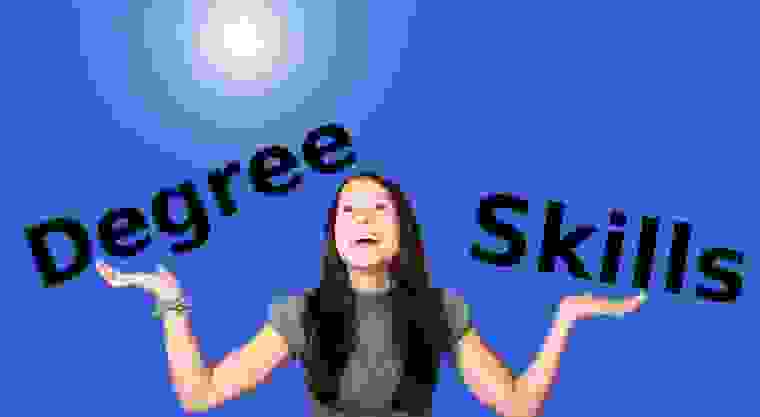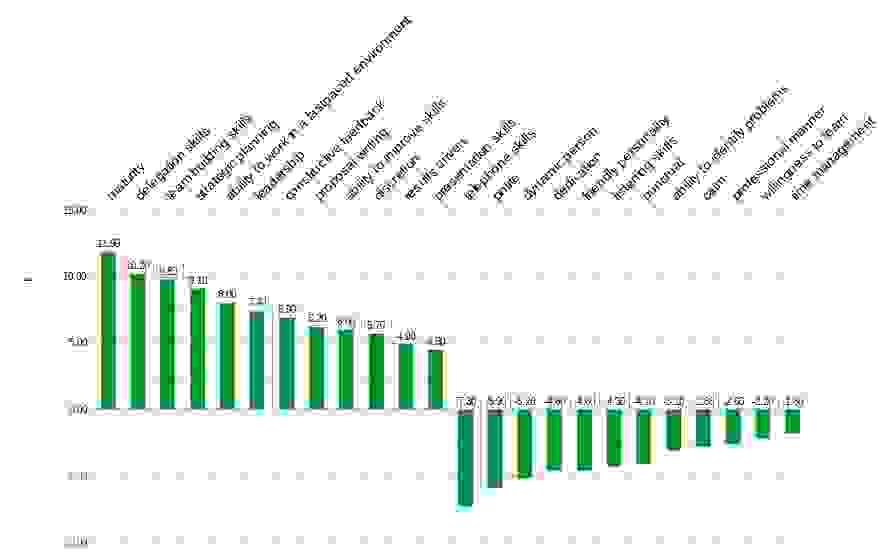Degree vs. Skills: Impact on salary
Several economics theories exist that attempt to explain how salaries and wages are determined. Nevertheless, instead of unraveling theories, we let the facts speak for themselves.
Many factors affect the total economic compensation, such as demand and supply of a specific skill, experience, location, unions, productivity, and so on, but here we look at the overall impact of education, specific knowledge, skills, and abilities.
First, we explore historical data and then hypothesize about future trends.
Historical Data: How Degrees have affected earnings and employment?
The US
The historical data are clearly showing that having less than a high school diploma, results in the highest unemployment rate and the lowest earnings (Figure 1).
The earnings have increased with an increasingly higher degree. We can also see that the highest degree possessors, professional and doctoral, have the lowest unemployment rate (Figure 1).
Although the magnitudes have changed from 2013 to 2018, the relationships are the same.
The EU
We can see a similar situation in the European Union, although the figures are not directly comparable due to differences between the EU and the US in taxation and welfare schemes (Figure 2).
The progressive taxation schemes and the minimum wages in the EU tend to narrow the gap between low and high incomes. Despite this, the tertiary degree holders earned 75% more than those who had at most lower secondary education (Figure 2).
The unemployment figures in the EU tell a similar story as in the US. The highest unemployment rate is among those who had the lowest education levels (Figure 3).
In 2013 the unemployment rate for the lowest education group was three times the unemployment level of tertiary degree holders, 19.2% and 6.4% respectively (Figure 3).
The historical data unquestionably show that a degree is essential to obtain a high income and lowers the risk of getting unemployed. However, "change is the only constant," as Heraclitus, a Greek philosopher put it. Very true still today and likely much faster than during his time.
Will the degrees be as valuable in the future as they have been in the past? We discuss this, but first, we explore the effect of soft skills on income levels.
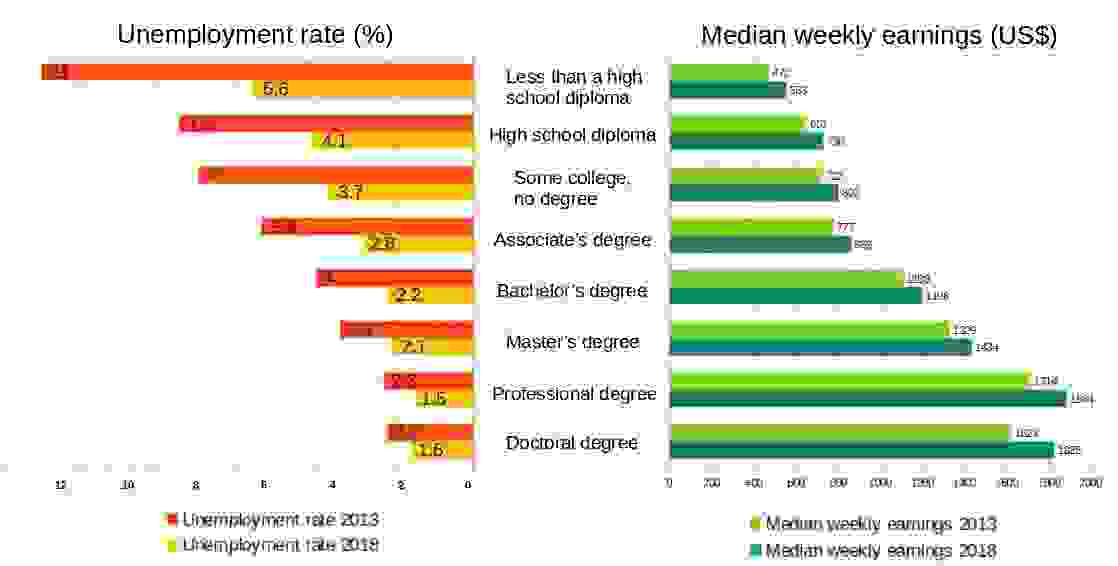
Median equivalized net income in Euro area v.s education levels from 2009 to 2017
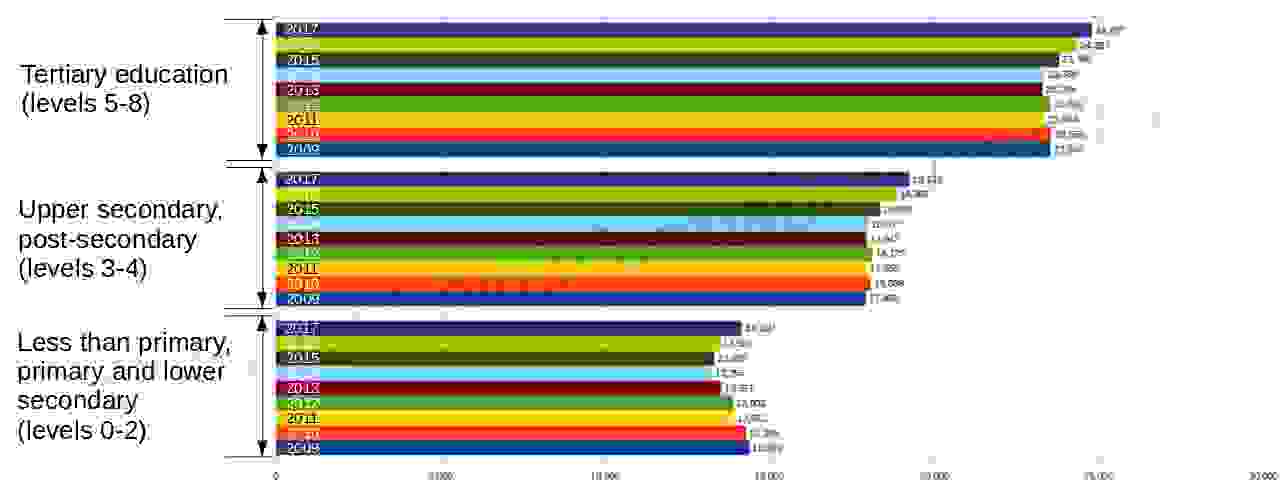
Unemployment rates by educational attainment level in the European Union
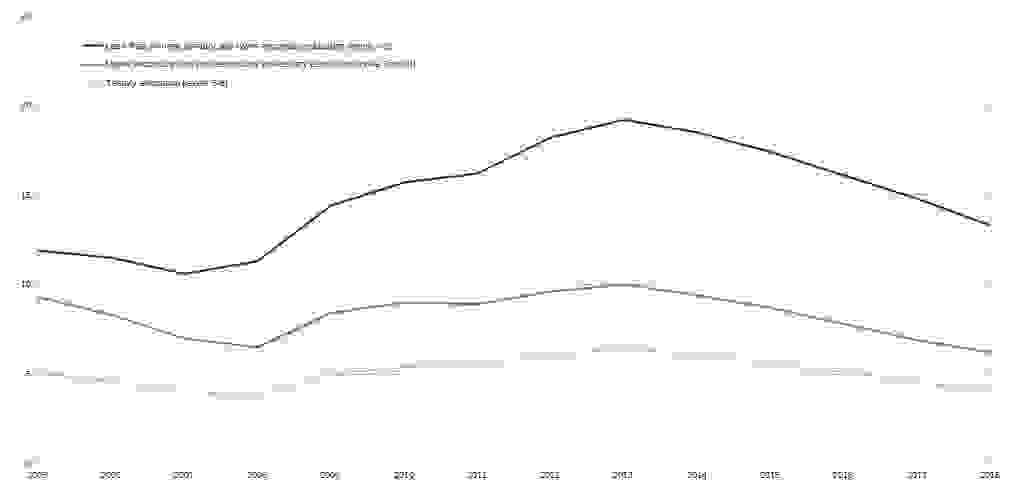
Historical Data: How Other Factors Affect Wages?
A large number of other factors besides education affects wages. We look particularly at personal characteristics and requirements for a specific occupation.
The list of personal characteristics includes abilities of which many are valid across occupations. These components measure the performance and the ability to gain knowledge and skills that affect productive work execution.
Cognitive abilities
Cognitive abilities are the most general ones and required in nearly every occupation. The cognitive capabilities measure an individual's capacity to acquire information and the ability to practice knowledge to solve problems.
Cognitive abilities include, for example, oral and written comprehension, inductive, and deductive reasoning.
Occupational requirements
Occupational requirements include common activities across numerous occupations as well as social and physical constituents that have an impact on a job.
Occupational requirements specify elements required for a specific job and include, for example, a list of mental processes, such as a requirement to update and apply appropriate knowledge, develop objectives and strategies, organize, plan, and prioritize work.
The complete set of the factors are at the bottom of this page.
Matthew Dey and Mark A. Loewenstein studied the 148 O*NET factors and their effect on wages using data from Occupational Employment Statistics (OES), covering the period of 2005 to 2017 and 788 occupations in the US.
They found the number of years of education alone explained 66.5% of the wage variation, and the O*NET factors alone could explain 93.3% of the wage variation during the period (Figure 4).
The combination of O*NET factors and the years of education explained 93.7 percent of the total wage variation. Dey and Loewenstein explain the small increase to be due to the fact that many of the O*NET factors measure similar attributes. Also, jobs consist of a composite of skills, activities, and working conditions, and the value comes from a particular combination suited for a specific job.
For example, some necessary skills required from bioinformatics scientists are critical thinking and reading comprehension, abilities such as written comprehension and ordering information, and specific domain knowledge in biology. A single skill, a piece of knowledge, or an ability alone is not enough, for a person to do the job satisfactorily.
Percent of wage variance explained by years of education and O*NET factors
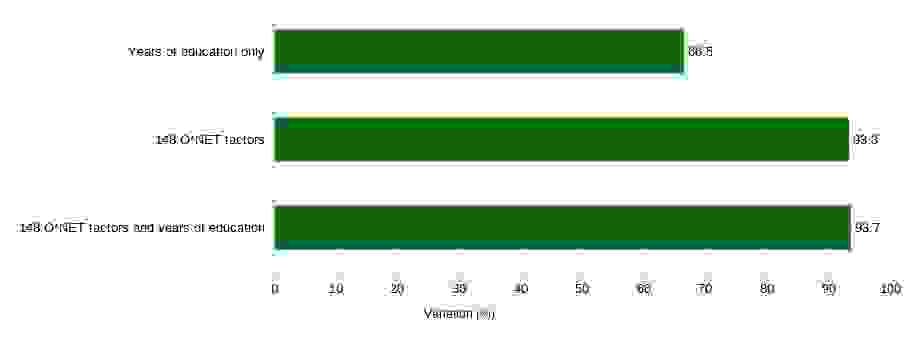
The results show that education only accounts for 66.5% of the wage variability. Over one-third of the variability of wages originates from other factors.
We have already seen that the education level is vital to achieve a good income and to reduce the risk of becoming unemployed (Figure 1, 2, 3). However, historical data tells us that a degree alone is not enough. We also need to grow a variety of skills and abilities. Most of them we can learn but are too often not included as subjects in specific educational programs.
How Soft Skills Affect Wages?
According to Dey and Loewenstein, other factors than degree causes 33.5% of wage variation.
A study of 245,000 job advertisements in the UK by Calanca et al. found that soft skills can yield both wage premiums and wage penalties (Figure 5).
We can divide soft skills into two categories:
- 1. Soft skills that are associated with highly skilled employees
- 2. Soft skills that are associated with low skill requirements.
These conclusions are further reinforced by WHICH-50 findings that salaries are positively affected by an increasing number of technical skills together with a growing number of soft skills. For example, possession of eight or more soft skills on top of a set of high-level technical skills resulted in a 40% salary increase in Australia.
Since soft skills are difficult to measure, we must include a certain amount of skepticism in all the results that involve soft skills.
The applied vocabulary used to describe soft skills varies, and evaluations are often subjective. Figure 6 shows the ranking of methods used by companies to evaluate soft skills.
Less than half of the companies use case studies and group interactions to evaluate soft skills. Also, less than one-third use role-play or simulations (Figure 6).
The Future: How Degrees and Soft Skills Affect Earnings and Employment?
College education and degrees will no doubt be significant hiring factors also in the future. Formal education provides a fundament for future learning. But, technologies are developing in an accelerated phase, and the attitudes are rapidly changing.
It takes lifelong learning to keep up with technology development. For instance, according to the World Economic Forum report (2019), over nine percent of the ASEAN youths at the age of 15 to 35 rated their skills already outdated.
Compare the above results with that you are on average about 33 years old when you get your Ph.D. in the US.
The rapid phase of development of new technologies may have resulted in the change of attitudes and hiring criteria in technology-intensive industry sectors. We should also not forget the fact that private companies develop a tremendous amount of cutting edge technologies and that, in many areas, academia is struggling to keep up.
These developments might be some of the reasons for many companies to contemplate hiring people that lack a formal college degree and to increased appreciation of soft skills.
The degrees are nevertheless significant, but in many large corporations, they are no longer a fixed barrier to get hired.
According to Glassdoor, several companies, including Apple, Bank of America, Google, and IBM, don't require a college degree in certain job positions.
Soft Skills in Demand
In LinkedIn Global Talent Trends 2019 survey, 92% of the companies said that soft skills matter as much or more than hard skills. Moreover, 80% believe that soft skills are growing in importance for company success.


The figures in the LinkedIn survey tally with the psionline.com findings that 67% of managers can consider hiring a person with robust soft skills, despite the hard skills are limited.
The Global Talent Trends 2019 survey additionally lists five soft skills of which the demand exceeds the supply. The soft skills are creativity, persuasion, collaboration, adaptability, and time management.
Bakhshi et al., in the study "The Future of Skills: Employment in 2030," predicted the future demand for skills and abilities using O*NET variables.
The Employment 2030 study paints a similar landscape of skills demand as the LinkedIn survey. Although, the words describing the abilities are different (Figure 7).
We can see that originality and fluency of ideas, for example, are on the top of the list both in the US and UK. If a person is creative, he or she should be original as well as fluent in ideas. That is, in other words, being creative.
Similarly, we find Learning strategies, instructing, social perceptiveness, and coordination on the top of the Employment 2030 skills list. These skills also resemble those of the LinkedIn survey findings, i.e., persuasion, collaboration, adaptability, and time management (Figure 8).
However, there is some variation between the US and UK abilities' and skills' rankings. Notably, learning strategies and instructing ranks on top in the US and the UK judgment and decision making, as well as active learning rank on the top in the UK.
A recent study of employers' ratings of skills importance Baird and Parayitam in 2019, similarly found 78% of the surveyed employers to rate communication skills the most important one.
Ranking of the importance of O*NET abilities to future demand for US and UK occupations.
Top 16 Abilities.
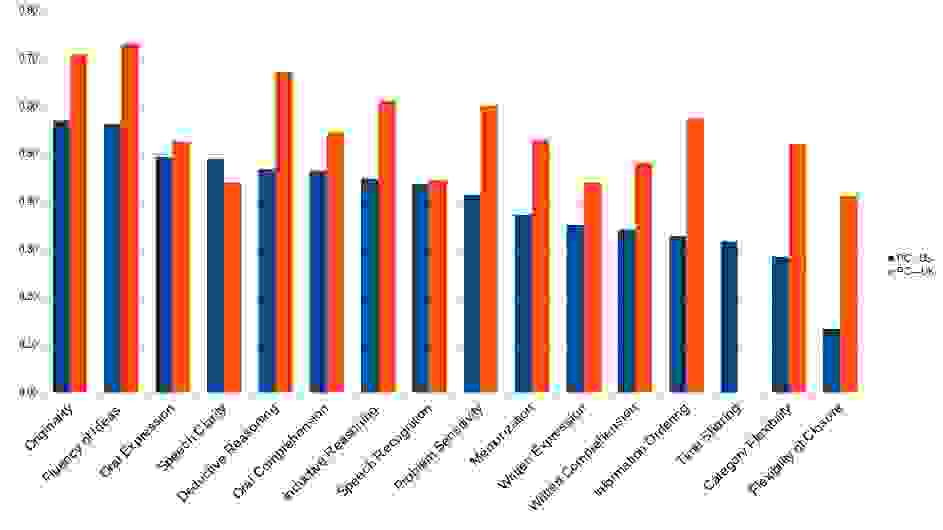
Ranking of the importance of O*NET skills to future demand for US and UK occupations.
Top 20 Skills.
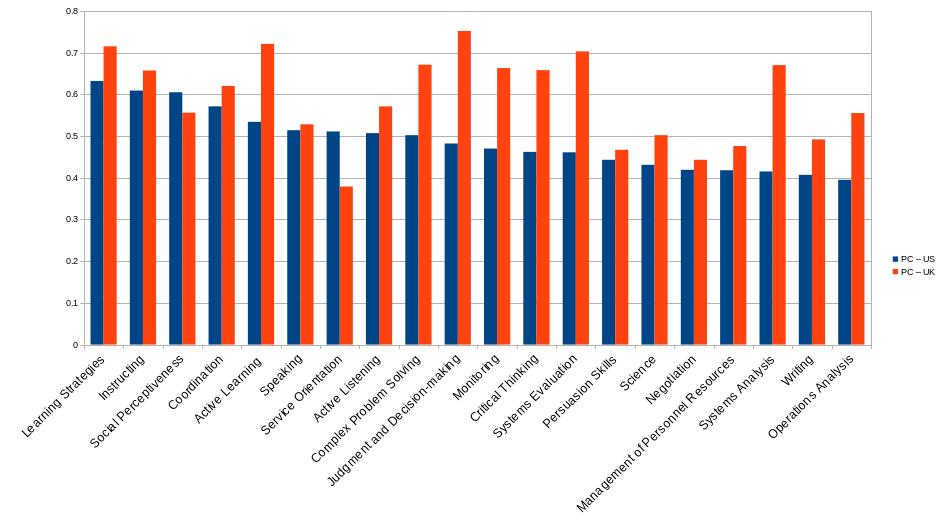
Conclusion
The hard statistics all paint the same picture, despite the differing phrasing.
Degrees will definitively be necessary even in the future, but if data is the oil of the 21st century, skills seem to the currency.
You may also be interested in the following
Career Outlook: Data and Bioinformatics Scientists (2018-26)
Find jobs - 16 country-specific databases
The list of 148 factors from O*NET Online used in this article
Persisting abilities of an individual that affect overall performance
- Cognitive Abilities
- These are abilities that influence the retrieval and utilization of knowledge in tasks requiring problem-solving. They are a common requirement across various jobs.
- - Oral Comprehension
- - Written Comprehension
- - Oral Expression
- - Written Expression
- - Fluency of Ideas
- - Originality
- - Problem Sensitivity
- - Deductive Reasoning
- - Inductive Reasoning
- - Information Ordering
- - Category Flexibility
- - Mathematical Reasoning
- - Number Facility
- - Memorization
- - Speed of Closure
- - Flexibility of Closure
- - Perceptual Speed
- - Spatial Orientation
- - Visualization
- - Selective Attention
- - Time Sharing
- Psychomotor Abilities
- These abilities affect the ability to handle and control objects.
- - Arm-Hand Steadiness
- - Manual Dexterity
- - Finger Dexterity
- - Control Precision
- - Multilimb Coordination
- - Response Orientation
- - Rate Control
- - Reaction Time
- - Wrist-Finger Speed
- - Speed of Limb Movement
- Physical Abilities
- Physical abilities influence strength, endurance, flexibility, balance, and muscle coordination.
- - Static Strength
- - Explosive Strength
- - Dynamic Strength
- - Trunk Strength
- - Stamina
- - Extent Flexibility
- - Dynamic Flexibility
- - Gross Body Coordination
- - Gross Body Equilibrium
- Sensory Abilities
- These abilities influence visual, auditory, and speech perception.
- - Near Vision
- - Far Vision
- - Visual Color Discrimination
- - Night Vision
- - Peripheral Vision
- - Depth Perception
- - Glare Sensitivity
- - Hearing Sensitivity
- - Auditory Attention
- - Sound Localization
- - Speech Recognition
- - Speech Clarity
- Information Input
- How and from where are the information and data obtained that are needed to perform this job?
- - Getting Information
- - Monitor Processes, Materials, or Surroundings
- - Identifying Objects, Actions, and Events
- - Inspecting Equipment, Structures, or Material
- - Estimating the Quantifiable Characteristics of Products, Events, or Information
- Mental Processes
- What processing, planning, problem-solving, decision-making, and innovating activities are required?
- - Judging the Qualities of Things, Services, or People
- - Processing Information
- - Evaluating Information to Determine Compliance with Standards
- - Analyzing Data or Information
- - Making Decisions and Solving Problems
- - Thinking Creatively
- - Updating and Using Relevant Knowledge
- - Developing Objectives and Strategies
- - Scheduling Work and Activities
- - Organizing, Planning, and Prioritizing Work
- Work Output
- Describes required physical activities, equipment operated/controlled, and technical activities for job outputs?
- - Performing General Physical Activities
- - Handling and Moving Objects
- - Controlling Machines and Processes
- - Operating Vehicles, Mechanized Devices, or Equipment
- - Interacting With Computers
- - Drafting, Laying Out, and Specifying Technical Devices, Parts, and Equipment
- - Repairing and Maintaining Mechanical Equipment
- - Repairing and Maintaining Electronic Equipment
- - Documenting/Recording Information
- Interaction with Others
- Describes interactions with other persons or supervisory activities required to do this job?
- - Interpreting the Meaning of Information for Others
- - Communicating with Supervisors, Peers, or Subordinates
- - Communicating with Persons Outside Organization
- - Establishing and Maintaining Interpersonal Relationships
- - Assisting and Caring for Others
- - Selling or Influencing Others
- - Resolving Conflicts and Negotiating with Others
- - Performing for or Working Directly with the Public
- - Coordinating the Work and Activities of Others
- - Developing and Building Teams
- - Training and Teaching Others
- - Guiding, Directing, and Motivating Subordinates
- - Coaching and Developing Others
- - Provide Consultation and Advice to Others
- - Performing Administrative Activities
- - Staffing Organizational Units
- - Monitoring and Controlling Resources
- Interpersonal Relationships
- This category describes the context of the job in terms of human interaction processes.
- - Public Speaking
- - Telephone
- - Electronic Mail
- - Letters and Memos
- - Face-to-Face Discussions
- - Contact With Others
- - Work With Work Group or Team
- - Deal With External Customers
- - Coordinate or Lead Others
- - Responsible for Others' Health and Safety
- - Responsibility for Outcomes and Results
- - Frequency of Conflict Situations
- - Deal With Unpleasant or Angry People
- - Deal With Physically Aggressive People
- Physical Work Conditions
- This category describes the work context as it relates to the interactions between the worker and the physical job environment.
- - Indoors, Environmentally Controlled
- - Indoors, Not Environmentally Controlled
- - Outdoors, Exposed to Weather
- - Outdoors, Under Cover
- - In an Open Vehicle or Equipment
- - In an Enclosed Vehicle or Equipment
- - Physical Proximity
- - Sounds, Noise Levels Are Distracting or Uncomfortable
- - Very Hot or Cold Temperatures
- - Extremely Bright or Inadequate Lighting
- - Exposed to Contaminants
- - Cramped Work Space, Awkward Positions
- - Exposed to Whole Body Vibration
- - Exposed to Radiation
- - Exposed to Disease or Infections
- - Exposed to High Places
- - Exposed to Hazardous Conditions
- - Exposed to Hazardous Equipment
- - Exposed to Minor Burns, Cuts, Bites, or Stings
- - Spend Time Sitting
- - Spend Time Standing
- - Spend Time Climbing Ladders, Scaffolds, or Poles
- - Spend Time Walking and Running
- - Spend Time Kneeling, Crouching, Stooping, or Crawling
- - Spend Time Keeping or Regaining Balance
- - Spend Time Using Your Hands to Handle, Control, or Feel Objects, Tools, or Controls
- - Spend Time Bending or Twisting the Body
- - Spend Time Making Repetitive Motions
- - Wear Common Protective or Safety Equipment such as Safety Shoes, Glasses, Gloves, Hearing Protection, Hard Hats, or Life Jackets
- - Wear Specialized Protective or Safety Equipment such as Breathing Apparatus, Safety Harness, Full Protection Suits, or Radiation Protection
- Structural Job Characteristics
- This category comprises the relationships or interactions between the worker and the structural characteristics of the job.
- - Consequence of Error
- - Impact of Decisions on Co-workers or Company Results
- - Frequency of Decision Making
- - Freedom to Make Decisions
- - Degree of Automation
- - Importance of Being Exact or Accurate
- - Importance of Repeating Same Tasks
- - Structured versus Unstructured Work
- - Level of Competition
- - Time Pressure
- - Pace Determined by Speed of Equipment
Work activities that are common across numerous occupations
Work context describes the physical and social constituents that influence the characteristics of the job
References
David H. Autor (2014). Skills, education, and the rise of earnings inequality among the “other 99 percent”. Science 23 May 2014: Vol. 344, Issue 6186, pp. 843-851. doi: 10.1126/science.1251868
Matthew Dey, Mark A. Loewenstein (2019). On Job Requirements, Skill, and Wages. Office of Survey Methods Research, Bureau of Labor Statistics, Office of Employment and Unemployment Statistics. WP-513
Jiří Balcar (2014). Soft Skills and their Wage Returns: Overview of Empirical Literature. REVIEW OF ECONOMIC PERSPECTIVES – NÁRODOHOSPODÁŘSKÝ OBZOR, VOL. 14, ISSUE 1, 2014, pp. 3–15, doi: 10.2478/revecp-2014-0001.
Federica Calanca, Luiza Sayfullina, Lara Minkus, Claudia Wagner, Eric Malmi (2019). Responsible team players wanted: an analysis of soft skill requirements in job advertisements. EPJ Data Sciencevolume 8, Article number: 13. doi: 10.1140/epjds/s13688-019-0190-z.
License: (CC BY 4.0)
Haselberger D, Oberheumer P, Perez E, Cinque M, Capasso D. (2012), Mediating Soft Skills at Higher Education Institutions, Handbook of ModEs Project, Education and Culture DG Lifelong Learning Programme, European Union, Brussels. PDF
License: (CC BY-NC 3.0)
Succi C, Wieandt M. (2019), Walk the talk: soft skills’ assessment of graduates, European Journal of Management and Business Economics, Vol. 28 No. 2, pp. 114-125. doi: 10.1108/EJMBE-01-2019-0011.
License: (CC BY 4.0).
Heckman JJ, Kautz T (2012).Hard evidence on soft skills. Labour Econ. 2012 Aug 1;19(4):451-464. doi: 10.1016/j.labeco.2012.05.014.
Françoise Delamare Le Deist, Jonathan Winterton (2005), What is competence?, Human Resource Development International, Vol. 8 No. 1, pp. 27-46. doi: 10.1080/1367886042000338227.
Jennifer Parlamis, Matthew J Monnot (2018). Getting to the CORE: Putting an End to the Term “Soft Skills.” Journal of Management Inquiry, 28(2), 225–227. doi: 10.1177/1056492618818023.
Mansour B, Dean J. (2016) Employability Skills as Perceived by Employers and University Faculty in the Fields of Human Resource Development (HRD) for Entry Level Graduate Jobs. Journal of Human Resource and Sustainability Studies, 4, 39-49. doi: 10.4236/jhrss.2016.41005.
LinkedIn 2019 Talent Trends: Soft Skills, Transparency and Trust. https://bit.ly/2NvZwlv.
Bakhshi H, Downing J, Osborne M, Schneider P (2017). The Future of Skills: Employment in 2030. London: Pearson and Nesta. ISBN: 978-0-992-42595-1.
License: (CC BY-NC-SA 4.0).
Pearson K (1901). On lines and planes of closest fit to systems of points in space. Philosophical Magazine Series 6 2 (11), 559–572. doi: 10.1080/14786440109462720.
Chiara Succi (2019). Are you ready to find a job? Ranking of a list of soft skills to enhance graduates' employability. International Journal of Human Resources Development and Management, 2019, vol. 19, issue 3, 281-297. inderscience
Baird A, Parayitam S (2019), Employers’ ratings of importance of skills and competencies college graduates need to get hired, Education + Training, Vol. 61 No. 5, pp. 622-634. doi: 10.1108/ET-12-2018-0250
